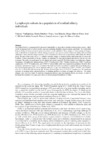Mostrar o rexistro simple do ítem
Lymphocyte subsets in a population of nonfrail elderly individuals
| dc.contributor.author | Valdiglesias, Vanessa | |
| dc.contributor.author | Sánchez-Flores, María | |
| dc.contributor.author | Maseda, Ana | |
| dc.contributor.author | Marcos Pérez, Diego | |
| dc.contributor.author | Millán-Calenti, José Carlos | |
| dc.contributor.author | Pásaro, Eduardo | |
| dc.contributor.author | Lorenzo-López, Laura | |
| dc.contributor.author | Laffon, Blanca | |
| dc.date.accessioned | 2015-10-06T08:32:17Z | |
| dc.date.issued | 2015-07-13 | |
| dc.identifier.citation | Valdiglesias V, Sánchez-Flores M, Maseda A, Marcos-Pérez D, Millán-Calenti JC, Pásaro E, et al. Lymphocyte subsets in a population of nonfrail elderly individuals. J Toxicol Environ Health A. 2015;78(13-14):790-804. | es_ES |
| dc.identifier.uri | http://hdl.handle.net/2183/15327 | |
| dc.description.abstract | [Abstract] Age-related frailty is characterized by increased vulnerability to stress due to decline in homeostatic reserve, which results in increased risk of adverse health outcomes including disability, hospitalization, and death. The relationship between frailty and immunological system alterations is well established. Thus, analysis of immunological changes, such as alterations in lymphocyte subsets, during senescence may provide useful markers for frailty and associated pathologies. Since reference ranges currently used for lymphocyte subsets do not specifically differentiate the elderly group, the aim of this study was to (1) establish reference ranges in nonfrail elderly individuals and (2) assess the evolution of these parameters with age. Further, the influence of other physiological and lifestyle factors was also evaluated. The study was performed on 144 elderly individuals (aged 65–95) from Galicia (in northwestern Spain). Percentages of lymphocyte subpopulations (CD3+ T lymphocytes, CD4+ T-helper lymphocytes, CD8+ T-cytotoxic lymphocytes, CD19+ B lymphocytes, and CD56+16+ natural killer cells) were analyzed in peripheral blood by flow cytometry, and reference ranges were calculated. The individual status as nonfrail or prefrail did not markedly affect the immunological parameters, but an apparent influence of age was obtained for %CD3+, %CD4+, and %CD19+ cells, all of which fell with increasing age. Women showed higher levels of %CD19+ lymphocytes. No significant influence of smoking habits, physical activity, or drinking alcohol or caffeine beverages was observed. The results obtained may serve as a basis to establish comparisons between frail and nonfrail elderly individuals, in order to determine the usefulness of lymphocyte subsets as immunological biomarkers of frailty. | es_ES |
| dc.language.iso | eng | es_ES |
| dc.publisher | Taylor & Francis | es_ES |
| dc.relation.uri | http://dx.doi.org/10.1080/15287394.2015.1051170 | es_ES |
| dc.rights | This is an accepted manuscript of an article published by Taylor & Francis in "Journal of Toxicology and Environmental Health, Part A" on 13 july 2015, avaliable online in Taylor & Francis Online platform. | es_ES |
| dc.title | Lymphocyte subsets in a population of nonfrail elderly individuals | es_ES |
| dc.type | info:eu-repo/semantics/article | es_ES |
| dc.rights.access | info:eu-repo/semantics/openAccess | es_ES |
| dc.date.embargoEndDate | 2016-07-13 | es_ES |
| dc.date.embargoLift | 2016-07-13 |
Ficheiros no ítem
Este ítem aparece na(s) seguinte(s) colección(s)
-
GI-GIGG - Artigos [113]






